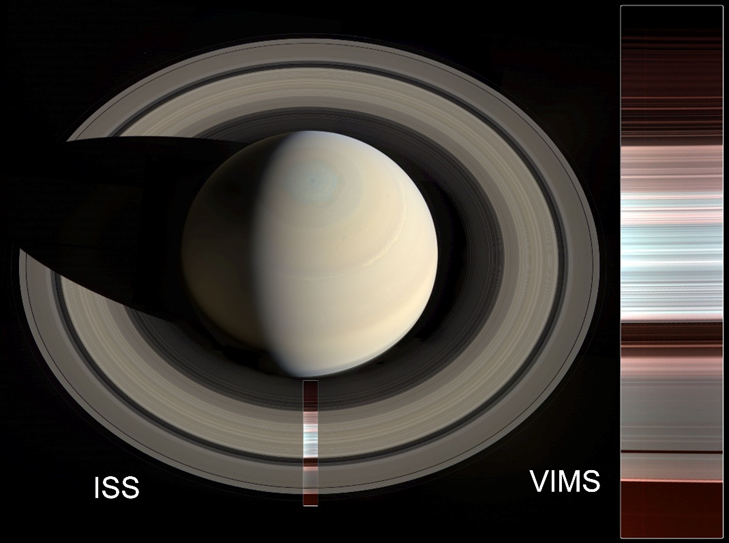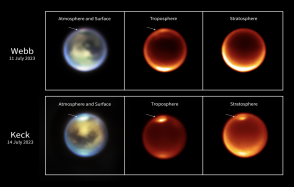“At the LPG, we concentrated on analysing the data from the VIMS hyperspectral imager, which was used in a very special mode to take maximum advantage of the low-level flybys carried out by Cassini,” explains Stéphane Le Mouélic, a CNRS researcher at the LPG (CNRS/Université de Nantes/Université d’Angers), who also worked with Sébastien Rodriguez, a researcher at the IPGP and lecturer at the Université Paris Diderot. “The result is a series of observations a few dozen pixels wide and several hundred pixels long, crossing all the rings and highlighting their spectral diversity. The rings, which are very finely structured, appear to be dominated by the infrared signature of water ice, with a more or less significant component of contaminants that may correspond to nanophase metallic iron particles. No traces of ammonia, methane or organic molecules were detected.
Cécile Ferrari, a researcher at the IPGP, professor at Paris Diderot University and co-investigator of the CIRS instrument, contributed to the analysis and interpretation of the observations made by the CIRS infrared spectrometer, which determined the temperature of the rings throughout the mission. “The temperature of the rings traces the dynamic behaviour of particles in the equatorial plane of the planet and also their internal structure (porosity, for example). We had already discovered that in the densest rings A and B, the more optically dense the ring (capable of absorbing incident sunlight), the greater the temperature gradient between its sunlit and non-sunlit sides”, which can be interpreted as being due to a greater thickness at this point. This behaviour was confirmed by the very high-resolution data obtained during the latest grazing orbits. “However, these latest observations have enabled us to obtain very good resolution on the narrower dynamic structures (in radial extent) of the A ring or the plateaus of the C ring, and have shown us that in the A ring we can observe a different behaviour, which can no doubt be explained by more pronounced vertical dynamics of the particles and more efficient heat transfer. In the C ring, despite the better resolution obtained on the plateaux, the noise remains high and it is difficult to establish a clear correlation between their optical depth and a stronger thermal gradient”.
Some questions have therefore been answered thanks to the probe’s dive into the heart of the rings, but many mysteries remain as to the dynamics of these structures and the scientists involved are now focusing on modelling the evolution of these rings.
The Cassini-Huygens mission is a cooperative project between NASA, the European Space Agency (ESA) and the Italian Space Agency. The Jet Propulsion Laboratory (NASA, Caltech) designed, developed and assembled the Cassini orbiter. The radio antenna was built by JPL and the Italian Space Agency, in collaboration with team members from the United States and several European countries.
Ref : M. S. Tiscareno, P. D. Nicholson, J. N. Cuzzi, L. J. Spilker, C. D. Murray, M. M. Hedman, J. E. Colwell, J. A. Burns, S. M. Brooks, R. N. Clark, N. J. Cooper, E. Deau, C. Ferrari, G. Filacchione, R. G. Jerousek, S. Le Mouélic, R. Morishima, S. Pilorz, S. Rodriguez, M. R. Showalter, S. V. Badman, E. J. Baker, B. J. Buratti, K. H. Baines, C. Sotin, Close-range remote sensing of Saturn’s rings during Cassini’s ring-grazing orbits and grand finale, Science, June 2019










